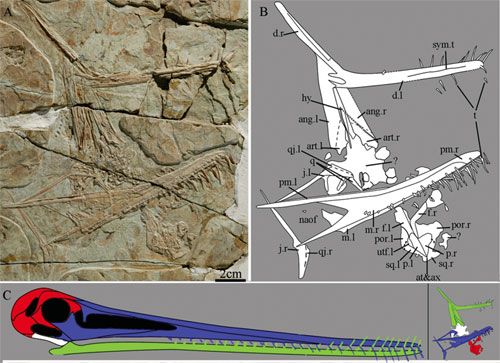| Location: Home > Research > Research Progress |
| New Ctenochasmatid Pterosaur Found from the Lower Cretaceous of China |
|
Drs. JIANG Shunxing and WANG Xiaolin from Institute of Vertebrate Paleontology and Paleoanthropology (IVPP), Chinese Academy of Sciences, described a new ctenochasmatid pterosaur, Pterofiltus qiui gen. et sp. nov., from the Lower Cretaceous deposits of Liaoning, China, as reported in Annals of the Brazilian Academy of Sciences (2011) 83(4): 1243-1249, providing further information on the global distribution of the ctenochasmatid, in Asia, Europe and America.
The new specimen (IVPP V12339) was collected from the shale of the lower Yixian Formation (about 125 Million years ago) at the Zhangjiagou locality, consisting of most part of skull and mandibles, and first two cervical vertebrae, which is housed in the Institute of Vertebrate Paleontology and Paleoanthropology, Chinese Academy of Sciences, Beijing, China. In the same locality, there are many other vertebrate fossils such as Dendrorhynchoides curvidentatus, Protarchaeopteryx robusta, Caudipteryx dongi , Caudipteryx zoui, and an immature iguanodontian unearthed. Five genera and species of ctenochasmatids has been reported before in China: Huanhepterus quingyangensis, Beipiaopterus chenianus, Cathayopterus grabaui, Gegepterus changae and Elanodactylus prolatus. Beipiaopterus and Elanodactylus are known only postcranial skeletons, whereas Huanhepterus, Cathayopterus and Gegepterus have partial or nearly complete skulls. Pterofiltrus qiui differs from other ctenochasmatid pterosaurs by the following combination of characters: about 112 teeth in total (including the upper and lower jaws); the dentition occupies more than 50% of the skull length; the anterior teeth vary in size; the mandibular symphysis is longer than half of the whole mandible length; in ventral view, an apparent symphyseal trough in the median part of the symphysis. “Pterofiltrus qiui is assigned to the Ctenochasmatidae based on the extremely elongated rostrum, a large number of slender teeth, and the upper anterior teeth inclined ventroanteriorly”, said WANG Xiaolin, coauthor and research designer, “The Jehol Biota comprises many pterosaurs and ctenochasmatids play a very important role. The amount of clade members is not big, but this clade has more taxa than many others. This new member provides further information on the global distribution of the ctenochasmatid, in Asia, Europe and America”. This study was supported by the National Science Fund for Distinguished Young Scholars, National Basic Research Program of China (973 Program) and National Natural Science Foundation of China .  Fig. 1: Pterofiltrus qiui gen. et sp. nov., IVPP V12339; photograph (A); line drawing (B) showing the general position of the elements; their relationship (C), blue, rostrum; green, mandible; red, posterior part of the skull; white, indeterminate.(Image by JIANG Shunxing) |